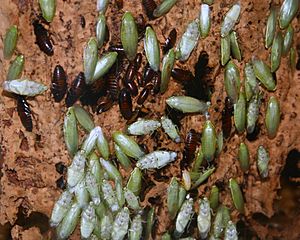Cuban cockroach facts for kids
Quick facts for kids Cuban cockroach |
|
|---|---|
 |
|
| Adults and nymphs | |
| Scientific classification | |
| Genus: |
Panchlora
|
| Species: |
nivea
|
| Synonyms | |
|
|
The Cuban cockroach, also known as the green banana cockroach, is a small insect. Its scientific name is Panchlora nivea. You can find this cockroach in Cuba and other Caribbean islands. It also lives along the Gulf Coast of the United States. This includes places from Florida to Texas. It has even been seen as far north as Summerville, South Carolina. These cockroaches prefer warm, subtropical or tropical places.
Contents
About the Green Banana Cockroach
This unique cockroach is often found outdoors. It rarely comes inside homes. Because of this, it is usually not seen as a bothersome pest. Adult green banana cockroaches often live in bushes, trees, and other plants. The young ones, called nymphs, hide under logs and other natural debris. They are mostly active at night. They are often drawn to lights, both inside and outside.
What Does It Look Like?
Adult female Cuban cockroaches can grow up to 24 millimeters long. The males are smaller, usually 12 to 15 millimeters long. Both males and females have wings. They are strong fliers. Their bodies are a pretty pale green to yellowish-green color. They also have a yellow line along their sides. Young cockroaches, the nymphs, look different. They are brown or black and like to burrow into the ground.
Life Cycle
The entire life cycle of a Cuban cockroach is typically 3 to 6 months.
- Stage 1: The Egg
Female Cuban cockroaches carry their eggs in a special case. This case is called an ootheca. It is about 3 to 4 millimeters long. The ootheca is curved and has small dents. These dents show where each egg is located inside. Studies have found that one ootheca can hold 28 to 60 eggs. On average, there are about 46 eggs.
The female carries the ootheca until the eggs are ready to hatch, which happens after approximately 4 to 6 weeks. After hatching, the young nymphs begin to grow.
- Stage 2: The Nymph
To grow, nymphs must shed their exoskeleton in a process called molting. Each molt is called an instar. The Cuban cockroach nymph goes through approximately 5 to 7 instars over a period of 2 to 5 months. Male nymphs take about 144 days to become adults. Female nymphs take a bit longer, maturing in about 181 days.
- Stage 3: The Adult
After the final nymphal molt, the adult cockroach emerges. Adults are sexually mature almost immediately after their final molt. Males are typically slightly smaller and thinner than females. After mating, the female will produce a new ootheca and the cycle repeats.
A Popular Pet?
The Cuban cockroach is sometimes kept as a pet. People like them because of their nice green color. Also, they don't usually try to invade homes. This makes them a less troublesome pet cockroach. They are also used as food for other pets, like lizards or spiders.
See also
 In Spanish: Panchlora nivea para niños
In Spanish: Panchlora nivea para niños

